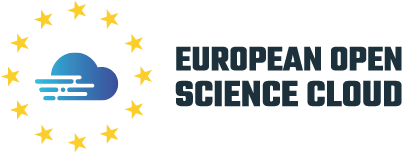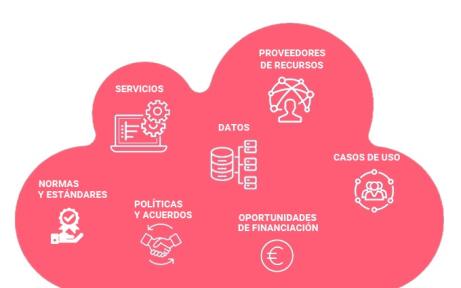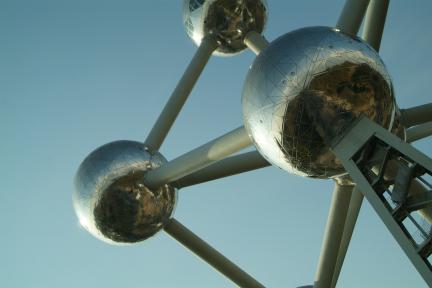
Open Science is a collaborative, transparent and accessible research model, in which access to scientific resources is improved and streamlined.
One of the aims of this model is to ensure that scientific results comply with the FAIR Principles (Findable, Accessible, Interoperable, Reusable), characteristics that digital research assets (data, software, publications) should meet, making them easy to find and to be accessed (e.g. through their inclusion in repositories that can be consulted by the community), as well as interoperable (i.e. following standards that facilitate their use), and reusable.
The European Commission, together with research organisations, legislators and funding bodies, is currently promoting this Open Science model as paradigm shift in the European research ecosystem through the launch of the European Open Science Cloud (EOSC). This transformation is based on the digital transition and data-driven science and aims to change the research process and the way research results are generated.
What is the EOSC
The EOSC aims to develop the "Web of FAIR and Data Services" to enhance access, reproducibility and the digital transformation of science in Europe.
The EOSC will consist of:
✓ An open multidisciplinary environment
✓ Where research staff, innovative sectors, business and citizens will be able to participate
✓ Making it possible to publish, search, find and reuse interoperable publications, data, tools and services
✓ Enabling visibility and thus enhancing their research work, reaching society as a whole

The EOSC builds on existing European data services and infrastructures, which are currently supported by the European Commission, Member States and the various research communities. The framework for its evolution and development is set out in the Strategic Research and Innovation Agenda (SRIA) document which defines the following three key objectives:

REWARDING OPEN SCIENCE
Ensure that open science practices are adequately rewarded, so that they become the "new normal"

FACILITATING SCIENTIFIC CONTRIBUTIONS
Foster and enable the definition of standards and the development of tools and services for people in the research ecosystem to easily contribute, find, access, reuse and combine their research results globally

BARRIER-FREE ACCESS TO SCIENCE
Establish a federated infrastructure that is sustainable and enables barrier-free access to scientific and research results
This environment will operate under a well-defined set of rules and conditions, ensuring the public interest of the environment. The ultimate aim of the EOSC is therefore to provide a multistakeholder environment where it is possible to find, access and use research data that is available in any infrastructure linked to the EOSC, enhancing international and interdisciplinary collaboration.
EOSC Governance
The EOSC is articulated as a European Partnership co-programmed through a tripartite collaboration:
1). The European Commission (representing the European Union)
2). The member countries represented by the Steering Board
3) The EOSC Association (EOSC-A) representing the research community
This governance model was materialised in the signature of the Memorandum of Understanding for a co-programmed partnership in July 2021, and involves all stakeholders in its development, sharing a joint vision, its overall objectives and complementary contributions at institutional, national and European level.
CSIC as a member of the EOSC Association
The EOSC partnership will enable the federation of data, resources, services and infrastructures (both existing and future) for open science in all scientific disciplines. To this end, the development of the EOSC foresees the creation of standards and best practices globally, in order to facilitate the interaction of the different systems. This is why collaboration with the different user communities is essential, so that the particular needs of their disciplines (e.g. data, metadata, standards, etc.) are taken into account.

CSIC was one of the 4 founding members of the association and is currently a mandated member of the association, in charge of national coordination. The CSIC's participation in the EOSC is carried out under the umbrella of the Vice-Presidency for International Relations (VRI).
The role of the EOSC for the CSIC is fundamental to provide technical and scientific staff with new opportunities in this vibrant ecosystem. Likewise, infrastructures and services will benefit from the technological developments that will take place in the EOSC, enabling the interoperability of resources, services and datasets.
On the other hand, EOSC aims to transform the way science is developed and above all shared, so the development of appropriate incentives, the change in the technical and scientific career, and in general the review process in the evaluation of science are of great relevance.
The CSIC participates in the working groups that will contribute to the definition of different aspects of EOSC, highlighting, among others, the following:
✓ Funding model for EOSC.
✓ Incentives and rewards related to the adoption of Open Science as a means of assessing research careers
✓ Rules of participation (i.e. who and how to include data and services in EOSC)
✓ Methods for user authentication and authorisation
✓ Recommendations for achieving interoperability of services and data
✓ Metrics for assessing the quality of services.
There is also an agreement between the European Union, represented by the European Commission, and EOSC-A, whereby EOSC-A commits to take into account suggestions from EOSC-A when defining topics for European funding calls that are within the scope and objectives of the SRIA.
Working Group EOSC-CSIC
Institutional Representation:
Isabel Díaz Carretero
Deputy Vice-Presidency of Internationalisation and Cooperation
Mónica Martín Lanuza
International Cooperation and Resources Coordinator
CSIC Scientific Representation in EOSC:
Álvaro López
IFCA-CSIC
Working group members:
Agnes Ponsati
URICI-CSIC
Isabel Bernal
URICI -CSIC
Laura Barrios
Head of Scientific Computing Area, SGAI-CSIC
Jacinto Vera
Head of Scientific Calculation Service-CSIC
Susana Sanchez Expósito
IAA-CSIC
Isabel del Bosque González
CCHS-CSIC
Susana Diez Tagarro
UTM-CSIC Marine Technology Unit
Laura del Caño
CNB-CSIC
Antònia Tugores
IFISC-CSIC